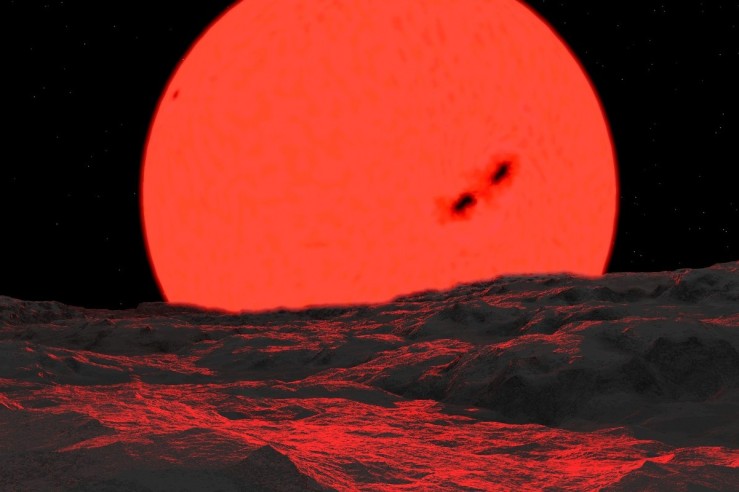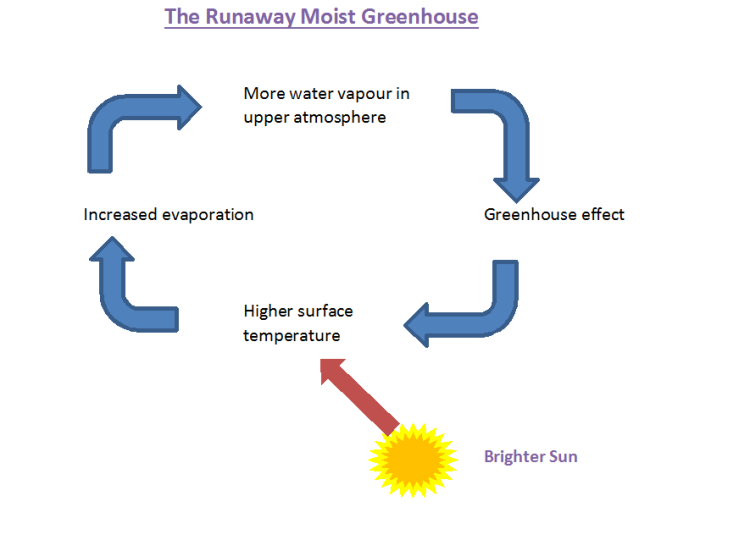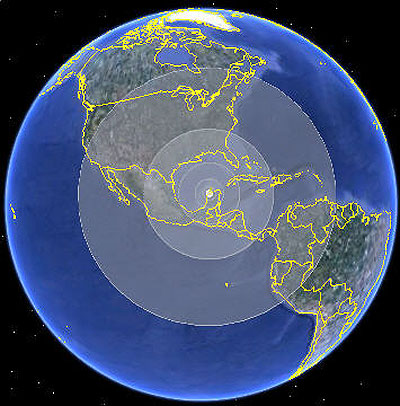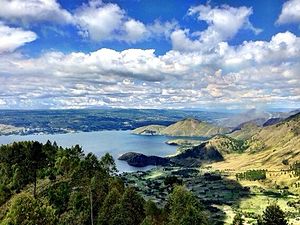As described in my previous post (The Future of the Sun), in about 5 billion years time the Sun will swell up to at least 100 times its current diameter and this will make the surface of the Earth far too hot to sustain life.
What Sunrise might look like when the Sun is a red giant.
This post discusses other natural events which could spell the end of life on Earth, long before the Sun becomes a red giant.
Gradual increase in the Sun’s brightness
Astrophysicists predict that the Sun is gradually increasing in brightness by 1% every hundred million years. This increase in solar output will, over the long term, cause a gradual warming of the Earth’s surface.
This is what will happen:
- The increased energy from the Sun will cause a warming of the Earth’s surface.
- Because water evaporates more rapidly at higher temperatures, there will be an increased rate of evaporation from the Earth’s seas and oceans.
- This will in turn lead to an increased concentration of water vapour in the Earth’s atmosphere.
- Water vapour is a very efficient greenhouse gas and will act to trap heat escaping from the Earth’s surface, making it even warmer.
- The temperature rise caused by the greenhouse effect will add to the temperature rise caused by the increased output from the Sun. This will lead to a higher surface temperature, which will lead to a greater rate of evaporation of water.
The process is actually called a runaway moist greenhouse, and is illustrated in the diagram below.
It has been calculated that, in roughly 1 billion years, which is long before it becomes a red giant, the combination of the Sun’s gradual increase in output and the moist greenhouse effect will make the Earth’s surface too hot for liquid water to exist (ref 1).
Comet or Asteriod impacts
About 65 million years ago a comet or asteroid approximately 10 km in diameter and weighing over 1 trillion tons hit the Earth (ref 2). You may recall from your high school science lessons that the energy that a moving object has varies with not its speed but its speed squared. What this means is that an object moving at 10 km per hour has 100 times the energy of an object of the same size moving at 1 km per hour and an object moving at 100 km per hour would have 10,000 times the energy. The comet or asteroid which collided with the Earth 65 million years ago may have hit the Earth with a speed of up 50,000 km per hour. This high speed coupled with its huge mass meant that it smashed into the Earth with an absolutely enormous energy. In fact the energy of the impact was equivalent to that released by 100 trillion tons of a high explosive called TNT (ref 2). This is 6 billion times greater than the atomic bomb dropped on Hiroshima at the end of the Second World War.
The impact melted much of the local crust and blasted molten material outwards. Any object near to the impact site would have been instantly vapourised. Such was the energy of the impact that some of the Earth’s crust was thrown upwards with so much force that it went out into space. Much of the remainder eventually came back to Earth over the next few hours which caused molten rock, dust and ash to rain down on an area millions of square kilometres in area. This hot material would have ignited fires, destroying plant and animal life within a large area.
The impact 65 million years ago occurred in what is now the Yucatan peninsula in Mexico. The outer ring shows the area which become covered in debris.
A fine cloud of dust from the impact circled the entire Earth. This blocked out sunlight, causing the Earth’s temperature to fall by about 15 degrees Celsius. The sudden drop in temperatures and lack of sunlight getting through meant that plant growth stopped for several months. As a result, many species of animals which fed on plants became extinct and the carnivores which fed on them became extinct too. Those species which did survive had their numbers reduced. In fact, nearly 75% per cent of the species of animal alive before the impact became extinct, including every species of dinosaur.
There has been many such large impacts throughout the history of the Earth and it is extremely likely than one will occur within the next 50 million years or so, although we can of course not predict when. The extremely rare possibility of this has nonetheless inspired a number of science fiction books and films!
Other events
Although a large comet or asteroid impact poses probably the greatest threat to life within the next 50 million years or so, there are other natural events which could effect the existence life on our planet and I have highlighted a few below.
Smaller Asteroid or Comet impacts.
Although large impacts, such as that which wiped out the dinosaurs, occur only once every 100 million years or so, smaller impact are much more common. The chances of an asteroid 1 km in diameter hitting the Earth are such that it will occur once every 500,000 years. Although the effects are less drastic than a more massive impact they are still substantial. An object 1 km in diameter smashing into the Earth, at a speed of 50,000 km per hour would have the explosive energy of around 100 billion tons of TNT and would devastate anything within 100 km of the impact site. It would throw up a thick cloud of dust into the upper atmosphere, which would cause global temperatures to drop by a few degrees for a year or so. This fall in temperature would have a massive effect on plant and animal life.
Supernovae. Massive stars end their lives in huge explosions called supernovae in which the star is totally destroyed and a massive amount of energy is released. When a star becomes a supernova it can briefly reach a peak brightness 5 billion times brighter than the Sun.
If a supernova were to occur within 30 light years of the Earth then the radiation emitted would severely damage the Earth’s upper atmosphere, letting harmful radiation hit the Earth’s surface. At the moment it is unclear how likely this is to happen. Only a very small percentage of stars end their life in supernova explosion but a recent scientific paper suggests that a supernova will occur within 30 light years of Earth every 300 million years (ref 3).
Large Volcanic Eruptions
Roughly 70,000 years ago, an enormous eruption occurred in what is now Sumatra, leaving behind Lake Toba. The huge eruption sent a cloud of dust and ash into the air which triggered a major environmental change which caused the near extinction of the human race. At one stage there were only 2000 individual humans alive on the planet.
Lake Toba, site of a supervolcano eruption 70,000 years ago
Such super volcanoes tend to occur a few times every million years.
For more information on the Toba eruption and its possible effect on humans, see http://toba.arch.ox.ac.uk/project.htm
What can humans do to survive these catastrophes?
Of all the natural threats, the most deadly to humanity would be if an asteroid or comet 10 km in diameter or larger were to strike the Earth. If this were to happen, all life within hundreds of kilometres of the impact would perish instantly. The sudden drop in temperatures of 15 degrees caused by the Sun being blocked out would cause crop failure and mass starvation. Conditions would be very harsh and many people living in currently hot countries might have trouble adapting without warning to colder temperatures. I don’t think humans would become extinct. We are too advanced for this and there would be sufficient food reserves for a proportion of the population to wait the few years or so before agriculture could be reestablished. People would not be able able to survive by hunting and gathering because there would be nothing to hunt and very little to gather.
At the moment, our space technology isn’t advanced enough to allow us to prevent such an impact. However, asteroids’ and comets’ orbits are plotted well enough that we are pretty certain that won’t be any such impact within the next few hundred years. I believe that long before the Earth is due to be hit by such a object, humanity or whatever species we have evolved into will be able to remove the threat. We could, for example, dispatch a spacecraft to explode a massive nuclear bomb to destroy the object, or deflect it into different orbit so it wouldn’t collide with the Earth.
What about man made disasters?
This post has described some possible natural scenarios which could spell the end of life on Earth. In addition to this there are other man made scenarios, such as a world wide nuclear war or a genetically engineered fatal disease. There is even the remote possibility (probably only really taken serious by lovers of science fiction) that humanity might be destroyed by an advanced artificial intelligence that it had itself created – a sort of killer robot.
Indeed what it is clear is that while humanity is confined to a single planet, the Earth, we are vulnerable to being wiped out by natural or man made disaster. In a recent article reported in the British newspaper The Independent Stephen Hawking, the famous theoretical physicist, believes that we should colonise other planets to ensure the survival of the human race.
“I believe that the long term future of the human race must be space and that it represents an important life insurance for our future survival, as it could prevent the disappearance of humanity by colonising other planets.”
Stephen Hawking 2015
References
1) http://www.redorbit.com/news/science/1113029594/earth-oceans-will-dry-up-in-a-billion-years-121713/
2) http://www.ucmp.berkeley.edu/education/events/cowen1b.html
3) Gehrels, Neil; Laird, Claude M. et al. (2003-03-10). “Ozone Depletion from Nearby Supernovae”. Astrophysical Journal 585 (2): 1169–1176









[…] Venus is closer to the Sun it has always been hotter than the Earth. As readers of a previous post will know the brightness of the Sun is gradually […]
LikeLike
I’m just happy to be here. Now.
LikeLike
My brother and his wife just came back from Yucatán,. Got to swim in some cenotes. Absolutely beautiful, crystal clear, glowing water.
LikeLike
Clearly, if we are hit by a big enough asteroid, our species will perish. But, like you, I’m optimistic that science will find a way to prevent this ‘armageddon’ before it happens. I think it much more likely that we will destroy ourselves by some other means, or that bacteria will do it or us.
LikeLike
I really enjoyed this post. Oh how I could ask you a thousand questions! Thanks for writing it.
LikeLike
Thank you for your kind comment and glad you enjoy reading my blog
The Science Geek
LikeLiked by 1 person
Reblogged this on Notes from the Overground and commented:
Taking the (very) long view!
LikeLike
Yes, it is a very long view, but given enough time it is inevitable that an asteroid or comets 10 km in diameter or larger will collide with the Earth, unless we have advanced to such a level that we ca prevent it happening
The Science Geek
LikeLike
Would a smaller asteroid or comet hitting the earth at an ocean have less long term effects globally? NIce article. Thanks.
LikeLike
A 1km asteroid hitting the Earth would have so much energy it would just push the water aside and hit the ocean floor with tremendous force to create a large crater.
The water pushed aside will form a huge tidal wave, a tsunami. The following link gives a little more detail
http://www.astronomynotes.com/solfluf/s5.htm
The Science Geek
LikeLike
Planetary diversification. Lets keep on trying to redeem the mess we’ve made on this one and get off-planet at the same time. Simple,eh? 😀
LikeLike
Pretty terrifying but with enough time to remedy some of this possible apocalyptic events. We have the insight and can prevent some of this events but do we really have the desire or commitment to do so.
LikeLike
Fingers crossed!!
A Prayer for the Disillusioned
LikeLike